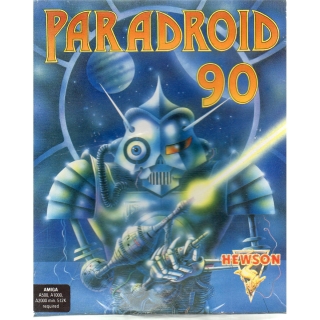PARADROID 90 AMIGA
PARADROID 90 AMIGA
Paradroid is a Commodore 64 computer game written by Andrew Braybrook and published by Hewson Consultants in 1985. It is a Shoot 'em up with puzzle elements that was critically appraised at release. The objective is to clear a fleet of spaceships of hostile robots by destroying them or taking them over via a mini-game. It was later remade as Paradroid 90 for the Amiga and Atari ST home computers and as Paradroid 2000 for the Acorn Archimedes. There exist several fan-made remakes for modern PCs. In 2004 the Commodore 64 version was re-released as a built-in game on the C64 Direct-to-TV and in 2008 for the Wii Virtual Console in Europe
Enemy forces have hijacked a space fleet by turning its robot consignment against the crew and your job is to neutralize all the robots, rescuing the humans. You control a prototype influence device that allows you to control the hostile robots.
The game is set on a spaceship viewed from a top-down perspective. The ship consists of numerous rooms and levels, each one populated by hostile robots or "droids". The player, in control of a special droid called the "Influence Device", must destroy all the other droids on the ship. Each droid (including the player) is represented as a circle around a three-digit number. The numbers roughly correspond to the droid's "power" or "level", in that higher-numbered droids are tougher to destroy.
The Influence Device is numbered "001". The primary way in which the Influence Device destroys other droids is by "linking" with them, effectively taking them over. When the player takes over another droid, the previously-controlled droid is destroyed.
Taking over a droid is done via a mini-game involving basic circuit diagrams and logic gates. Each droid has one side of the screen, with a series of logic gates and circuits connected together. The droids have a number of "power supplies" that can apply power to one circuit. Higher-numbered droids have more power supplies. At the end of a short time period, the droid supplying the most power to the circuit "wins". The logic gates are the key to allowing lower-numbered droids to beat higher-numbered droids. There is also a strategy in timing when power is applied to a circuit (as two supplies of power to the same circuit result in the later supplier of power gaining control of the circuit).
In either case, the droid being controlled by the player is destroyed. If the player beats the droid in this mini-game, he takes control of that droid. If not, either the droid is destroyed and the player returned to the game as just the Influence Device (if he was previously controlling a different droid), or the player is killed, ending the game, if he was not already controlling another droid before the takeover attempt.
While in control of another droid, the player effectively acts as that droid, meaning the player has access to that droid's maneuverability, armor, weapons and "power supplies" (used during the droid-control mini-game). If the droid has weapons, the player can destroy other droids simply by shooting them, instead of taking them over (though higher-numbered droids can require several shots to destroy, and might actually fire back). The player only has control of a droid for a limited amount of time (which is inversely proportional to the droid's number). If that time elapses, the controlled droid is destroyed and the player reverts to the Influence Device (001).
The spaceship has several decks, and each deck can have several rooms. Doors and elevators connect the rooms and the decks. Many rooms have computer terminals that provide access to maps of the current deck and the entire ship as well as droid information. Each droid can access information about itself and all lower-numbered droids (this access is available to the player based on the droid being controlled)
KOMPLETT I BOX


